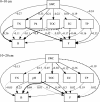Spatial patterns in soil physicochemical and microbiological properties in a grassland adjacent to a newly built lake
- PMID: 31472010
- PMCID: PMC6925176
- DOI: 10.1002/mbo3.912
Spatial patterns in soil physicochemical and microbiological properties in a grassland adjacent to a newly built lake
Abstract
Soil water content (SWC) is an important determinant for nutrient cycling and microorganism activity in the grassland ecosystem. Lakes have a positive effect on the water supply of the neighboring ecosystem. However, information evaluating whether newly built lakes improve the physiochemical properties and microorganism activity of adjacent grassland soil is rare. A 15-hectare artificial lake with a 2 m depth was built on grazed grassland to determine whether the change of soil physiochemical properties and microorganism activity of the adjacent grassland depended on the distance from the lake. SWC and total nitrogen (TN) were greater within 150 m of the lake than at distances over 150 m from the lake. The total organic carbon (TOC) increased first at 100-150 m from the lake and then decreased. The soil microbial biomass and the bacterial and fungal contents increased with increasing years after the construction of the lake. Gram-negative bacteria and methanotrophic bacteria were greater within a 30 m distance of the lake. Over 60 m away from the lake, Actinobacteria, gram-positive bacteria, and anaerobic bacteria showed higher abundances. In the area near the lake (<250 m distance), microorganisms were strongly correlated with SWC, EC, TN, and TOC and greatly correlated with the changes of total phosphorous (TP) and pH when the distance from the lake was over 250 m. The results indicated that the newly built lake could be a driving factor for improving the physiochemical properties and microorganism activity of adjacent grassland soil within a certain range.
Keywords: bacteria; grazing grassland; soil property; soil water content; the newly built lake.
© 2019 The Authors. MicrobiologyOpen published by John Wiley & Sons Ltd.
Conflict of interest statement
The authors declare no conflict of interest.
Figures






Similar articles
-
Optimizing Cyanobacterial Biomass for Soil Restoration: Nutrient Enrichment and Microbial Modulation in Degraded Grasslands of Hulun Lake.Bull Environ Contam Toxicol. 2025 May 10;114(5):75. doi: 10.1007/s00128-025-04030-z. Bull Environ Contam Toxicol. 2025. PMID: 40348937
-
[Response of Microbiological Properties to Short-term Nitrogen Addition in Perennial Alpine Cultivated Grassland].Huan Jing Ke Xue. 2024 Dec 8;45(12):7316-7325. doi: 10.13227/j.hjkx.202312228. Huan Jing Ke Xue. 2024. PMID: 39628195 Chinese.
-
The changing characteristics of phytoplankton community and biomass in subtropical shallow lakes: Coupling effects of land use patterns and lake morphology.Water Res. 2021 Jul 15;200:117235. doi: 10.1016/j.watres.2021.117235. Epub 2021 May 12. Water Res. 2021. PMID: 34034101
-
The Mixed Addition of Biochar and Nitrogen Improves Soil Properties and Microbial Structure of Moderate-Severe Degraded Alpine Grassland in Qinghai-Tibet Plateau.Front Plant Sci. 2021 Nov 22;12:765041. doi: 10.3389/fpls.2021.765041. eCollection 2021. Front Plant Sci. 2021. PMID: 34880889 Free PMC article.
-
Using enzyme activities as an indicator of soil fertility in grassland - an academic dilemma.Front Plant Sci. 2023 Jul 7;14:1175946. doi: 10.3389/fpls.2023.1175946. eCollection 2023. Front Plant Sci. 2023. PMID: 37484467 Free PMC article. Review.
References
-
- Abbasi, M. K. , & Adams, W. A. (2000). Gaseous N emission during simultaneous nitrification–denitrification associated with mineral N fertilization to a grassland soil under field conditions. Soil Biology & Biochemistry, 32, 1251–1259.
-
- Bao, S. D. (2013). Soil and agricultural chemistry analysis. Beijing, China: China Agriculture Press.
-
- Bardgett, R. D. , Hobbs, P. J. , & Frostegård, Å. (1996). Changes in soil fungal: Bacterial biomass ratios following reductions in the intensity of management of an upland grassland. Biology and Fertility of Soils, 22, 261–264.
-
- Bastida, F. , Torres, I. F. , Andrés‐Abellán, M. , Baldrian, P. , López‐Mondéjar, R. , Větrovský, T. , & López‐Serrano, F. R. (2017). Differential sensitivity of total and active soil microbial communities to drought and forest management. Global Change Biology, 23, 4185–4203. - PubMed
Publication types
MeSH terms
Substances
LinkOut - more resources
Full Text Sources

